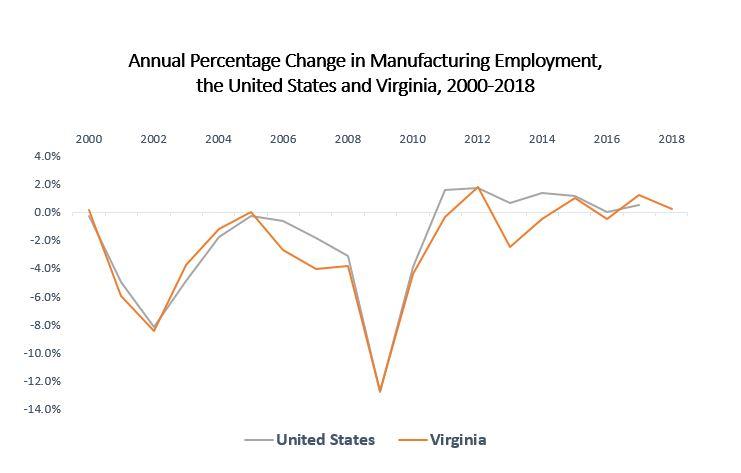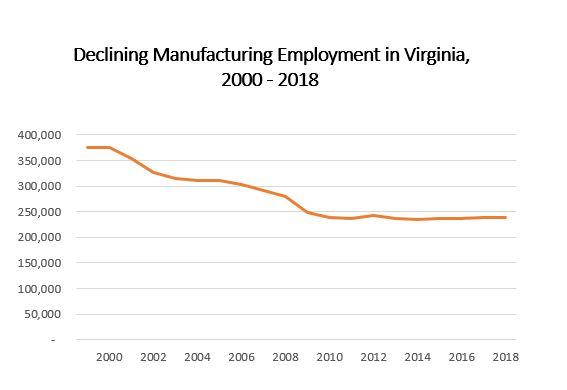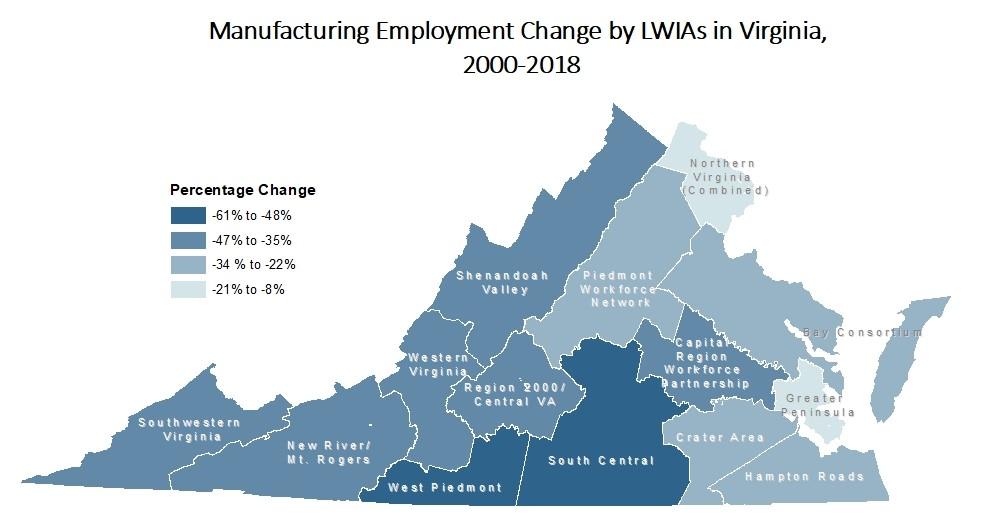Manufacturing Employment in Virginia
Manufacturing has played a significant role in U.S history. In 1790, during the first State of the Union address, President George Washington highlighted the importance of manufacturing for military supplies: “their (A free people) safety and interest require that they should promote such manufactories, as tend to render them independent on others, for essential, particularly for military supplies.” By 1970, the United States had achieved economic power through manufacturing, which provided a quarter of the total employment at the time. Most recently, however, the manufacturing sector is at the center of most economic discussions regarding its decline in the number of jobs.

U.S manufacturing has experienced unprecedented employment declines since 2000, due to a shift towards a service economy, an increase in technological innovation which boosts productivity, and an imbalance in global trade. In a Bureau of Labor Statistics list of “20 Industries with Most Rapidly Declining Wage and Salary Employment, 2016-2026,” 14 of them are from the manufacturing sector. Virginia, too, witnessed a downward trend in manufacturing jobs despite its growth in output. The graph below shows the annual percentage change in manufacturing employment in the U.S and Virginia between 2000 and 2018. Overall, the trend of manufacturing employment in Virginia has been similar to the national trend.

Between 2000 and 2018, 135,886 manufacturing jobs were lost in Virginia, which is a 36 percent decrease. In 2018, the manufacturing sector provided 239,401 positions – approximately 6 percent of the total nonfarm employment. Generally, all LWIAs (Labor Workforce Investment Areas) in Virginia have experienced a decline in manufacturing employment, but in West Piedmont, Capital Region Workforce Partnership, Region 2000/ Central VA, New River/Mt. Rogers, Shenandoah Valley, and Southwestern Virginia, the percentage decrease for manufacturing exceeds the state average.


The manufacturing sector consists of 21 different subsectors, but in Virginia, employment has been highly concentrated in the Transportation Equipment subsector and Food Manufacturing subsector. Between 2000 and 2018, jobs in transportation equipment manufacturing have declined 1 percent. Meanwhile, employment in food manufacturing has fallen by 15 percent. Most of the jobs related to these subsectors exist in Greater Peninsula, Shenandoah Valley, and Hampton Roads. The output from Food, Beverage, and Tobacco Products Manufacturing in Virginia was worth $18.5 billion in 2016 according to the Center for Manufacturing Research. Meanwhile, Textile Mills, Textile Product Mills, and Apparel Manufacturing each account for a smaller share of manufacturing employment than they did 18 years ago. Noticeably, Textile Mills and Apparel Manufacturing subsectors have lost a substantial number of jobs during that time – 83% and 87% respectively.

So, what are the prospects of Virginia’s manufacturing employment moving forward? According to long-term industry projections by Virginia Economic Commission (VEC), employment in the manufacturing sector in Virginia will continue to decrease by 5.7 percent between 2016 and 2026. At the LWIA level, South Central, Northern Virginia and Region 2000/ Central VA are projected to lose a higher percentage of jobs as shown in the table below. Moreover, the decline of employment is expected to be highest in Apparel Manufacturing at 34.7 percent. The continuous decline projected by VEC is consistent with the national trend. Based on the Bureau of Labor Statistics forecast, the number of U.S. manufacturing jobs will continue to fall at an average annual rate of 0.6% per year between 2016 and 2026.

The manufacturing sector raises demand and creates indirect job opportunities in other sectors of the economy, and employs blue-collar workers, especially those with only a high-school education. The continuing decline in manufacturing employment can trigger adverse economic and social consequences, worsening inequality. The Bureau of Labor Statistics suggests that job losses in manufacturing sectors have likely contributed to “the decline in labor force participation rate of the prime age (between the ages of 21 and 55) U.S. workers.” My next blog post will examine how this downward trend in manufacturing jobs has impacted specific populations in Virginia.


